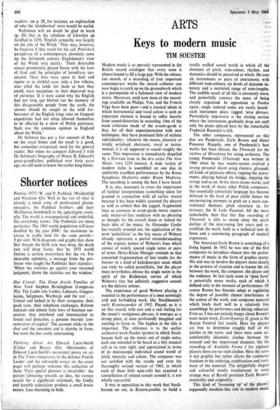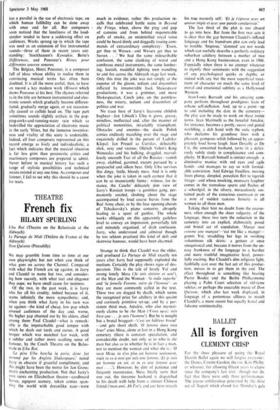Keys to modern music ARTS
TIM SOUSTER
Modern music is so sparsely represented in the British record catalogue that every issue is almost bound to fill a large gap. With the release, last month, of a recording of four important contemporary works the record collector can now begin to catch up on the groundwork which is a prerequisite of a balanced view of modern music. Moreover, until now most of the record- ings available on Philips, Vox, and the French Vdga have been poor—and a musical idiom in which instrumental and vocal colour is such an important element is bound to suffer heavily from sound-distortion in recording. One of the main criticisms made of the avante-garde is that, for all their experimentation with new techniques, they have produced little of stylistic individuality: whatever the means, aleatoric or totally serialised, electronic, vocal or instru- mental, it is all supposed to sound roughly the same. This impression is immediately dispelled by a first-rate issue in the RCA series The New' Music, vrcs 1239 (stereo). A wide variety of modern styles is assembled on one disc in uniformly excellent performances by the Rome Symphony Orchestra under Bruno Maderni. The recording is among the best I have heard. • It is, alas, necessary to stress the importance of faithful interpretation (something taken for granted in connection with all earlier music)" because it has been widely assumed (by players' - as well as critics) that the jagged, fragmented lines so common in avant-garde music require only matter-of-fact rendition with no phrasing or thought for the overall shape or indeed the basic idea of the music. As Alexander Goehr has recently pointed out, the application of the term 'pointillistic' to the late music of Webern already represents a partial misunderstanding of the organic nature of Webern's lines which consist of widely spaced single notes or pairs of notes. Heinz-Klaus Metzger reminds us that concerted fragmentation of line results for the listener in a kind of kaleidoscopic stasis which can truly be called pointillistic, but the player must *nevertheless phrase his single notes in the spirit of the Brahmsian curves of which Webern's tiny but infinitely suggestive sounds are the delicate echoes.
The experience of good Webern playing is essential to the performance of a once seemingly arid and forbidding work, like Stockhausen's early Xontra-punkte of 1952. Played, as it is on this record, with zest and a real feeling for the music's vertiginous phrases, it emerges as a strong piece, at once profoundly imagined and exciting to listen to. The hyphen in the title is important. The reference is to the earlier orchestral work Punkte (points) in which Stock- hausen built up the music out of single notes, each one intended to be heard as a tiny musical cell in its own right, and appreciated in terms of its microscopic individual sound world of pitch, intensity and colour. The composer was not satisfied with the results and even the thoroughly revised version of 1963, in which each of these little note-cells has acquired a constellation of related sounds around it, is not wholly successful.
It was in opposition to this work that Stock- hausen set out, in Kontra-punkte, to build a totally unified sound world in which all the elements of pitch, tone-colour, rhythm, and dynamics should be perceived as whole. He uses six instruments or pairs of instruments with different tone-colours, six levels of dynamic in- tensity and a restricted range of note-lengths. The audible result of all this is extremely tense. and powerfully conveys the sense of being closely organised. In opposition to Punkte again, single isolated notes are rarely heard: each instrument plays rugged, terse phrases. Particularly impressive is the closing section where the instruments gradually drop out until only the piano (played here by the remarkable ' Frederick Rzewski) is left.
The other composers represented on this" disc are Penderecki, Earle Brown and Henri' Pousseur. Happily, one of Penderecki's best works has been chosen, the Threnody for the' victims of Hiroshima for string orchestra. The' young Penderecki (Threnody was written in 1960 when he was twenty-seven) evolved a strong personal idiom using clusters, glissandi,' all kinds of pizzicato effects, tapping the instru- ments, playing behind the bridge, slapping' the strings and so on. In his more recent works, and' in the work of many other Polish composers, this essentially colouristic language has become debased to the level of pure cliché (hence the unconvincing attempts to graft on a more con- ventional thematic pitch, structure in, for instance, the Sr Luke Passion). All the more remarkable then that this fine recording of Threnody is able to sweep away the quick decline of the intervening few years and re- establish the work, both as a technical tour de force and a convincing paragraph of musical' expression.
The American Earle Brown is something of a, living legend. In 1952 he was one of the first' composers to introduce chance into the perfor-, mance of music in the form of graphic scores.. His aim was to involve the players more closely, in the process of creation and to loosen the ties between the work, the composer, the player and the audience. In fact each score in 'open forthf. is potentially many works, each of which is defined only at the moment of performance. Of course Brown has become adept at regulating the degree of possible chance interference in the course of the work, and composes material which lends itself well to a relatively free assemblage by performers and during rehearsal. Even so, I was not entirely happy about Brown's most recent work, Event-Synergy II, given at the Royan Festival last month. Here the players are free to determine roughly half of the pitches in the score, and there were some un- comfortably idiomatic clashes between the notated and the improvised elements. On the, recording of Available Forms I for eighteen players there are no such clashes. Here the score is not graphic but rather allows the conductor freedom in the ordering, combination and treat- ment of the material. The delightfully elegant and colourful results (reminiscent in some strange way of Ravel) proclaim Earle Brown's musicality and originality. This kind of 'loosening up' of the Players' supposedly machine-like role in modern music has a parallel in the use of electronic tape, on which human fallibility can be done away with once and for• all. But composers soon noticed that the loneliness of the loud- speaker tended to have a saddening effect on audiences. Works sprung up in which the tape was used as an extension of live instrumental sounds—three of them in recent years out- standing: Stockhausen's Kontakte, Berio's Differences, and Pousseur's Burnes pour differentes sources sonores.
The Belgian, Henri Pousseur, is a composer full of ideas whose ability to realise them in convincing musical terms has often been doubted. It is all the more useful, then, to have on record a key modern work (Rimes) which shows Pousseur at his best; The rhymes referred to in the. title are between instrumental and elec- tronic sounds which gradually become differen- tiated, gradually merge again, or are occasion- ally caused to collide head on. The tape part sometimes sounds slightly archaic in the pop- ping-corks-and-running-water vein which so bedevilled the appreciation of electronic music in the early 'fifties, but the immense inventive- ness and vitality of this score is undeniable. Indeed, all four composers represented on this record emerge as lively and individualistic, a fact which indicates that the musical situation is far less grim than pessimistic critics and reactionary composers are prepared to admit. Never before in musical history has such a range of stylistic possibilities and technical means existed at any one time. As composer and listener, I fail to see why this should be a cause for tears.







































 Previous page
Previous page